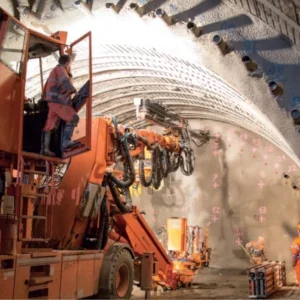
As we look forward to Bauma 2025, the world’s leading trade fair for construction machinery, building material machines, mining machines, construction vehicles, and construction equipment, it is essential to reflect on the pivotal role this event plays in shaping the future of the mining and tunneling industries.
With a focus on decarbonisation, automation, and digitalisation, Bauma serves as a vital platform for innovation, collaboration, and the exchange of ideas that will drive our industries forward in an increasingly complex and environmentally conscious world.
Decarbonisation
The mining industry is at a crossroads, facing the urgent need to reduce its carbon footprint in response to global climate change. Decarbonisation is not merely a trend; it is a necessity for the sustainability of our planet and the future of our industries.
At Bauma 2025, we will witness groundbreaking technologies and solutions that aim to minimise emissions and enhance energy efficiency. Exhibitors will showcase advancements in electric and hybrid machinery, alternative fuels, and carbon capture technologies. These innovations are crucial for the mining sector, which has historically been associated with high energy consumption and greenhouse gas emissions.
The tunnelling industry, too, is not exempt from this responsibility. As we dig deeper into the earth, we must ensure that our methods and machinery align with the global push for sustainability.
The collaborative spirit of Bauma provides an opportunity for stakeholders from both industries to come together and share best practices.
In coming together and sharing, strategies are developed that prioritise environmental stewardship. By fostering partnerships and encouraging dialogue, we can accelerate the transition towards a low-carbon future.
Automation
Automation is revolutionising the mining and tunnelling sectors, offering unprecedented opportunities to enhance operational efficiency and safety.
At Bauma 2025, we can expect to see a plethora of automated solutions that streamline processes, reduce human error, and improve overall productivity.
From autonomous vehicles to advanced robotics, the integration of automation technologies is transforming how we approach mining and tunnelling projects. These innovations not only optimise resource extraction but also mitigate risks associated with manual labour in hazardous environments. The safety of our workforce is paramount, and automation plays a critical role in minimising exposure to dangerous conditions.
Moreover, the adoption of automation can lead to significant cost savings and increased competitiveness in a global market that demands efficiency.
As we gather at Bauma, it is essential to explore how these technologies can be implemented effectively across various operations, ensuring that both the mining and tunnelling industries can thrive in an era of rapid change.
Digitalisation
Digitalisation is another key theme that will be prominently featured at Bauma 2025. The integration of digital technologies into mining and tunnelling operations is transforming how we collect, analyse, and utilise data. The rise of the Internet of Things (IoT), big data analytics, and artificial intelligence (AI) is enabling companies to make informed decisions based on realtime information.
At Bauma, we will see innovative software solutions and digital platforms that enhance project management, improve resource allocation, and facilitate predictive maintenance. These advancements not only increase efficiency but also contribute to sustainability efforts by optimising resource use and reducing waste.
The tunnelling industry stands to benefit from digitalisation through enhanced monitoring and control systems. By leveraging data analytics, we can better understand geological conditions, predict potential challenges, and implement proactive measures to ensure project success.
As we embrace digital transformation, it is crucial to foster a culture of innovation and continuous learning within our organisations. Bauma provides an ideal environment for knowledge exchange, allowing industry leaders to share insights and experiences that can drive digital adoption across the mining and tunnelling sectors.
Looking forward to welcoming you at our VDMA Mining & Minerals booth in hall C2.
BAUMA INNOVATION AWARDS SHORTLIST
Two technical systems for tunnel enlargement and spoil measurement, respectively, have been shortlisted for the 2025 Bauma Innovation awards. The systems are in separate categories and are among 15 shortlisted entries, the winners to be announced at the construction equipment exhibition, in April, in Munich.
The two shortlisted technical systems of particular interest to tunnellers are: Herrenknecht’s Tunnel Enlargement System (TES); and, from Technische Hochschule Koln, an artificial intelligence-based (AI) muck measuring system for earth pressure balance (EPB) tunnel boring machines (TBMs).
The former is in the Mechanical Engineering shortlist category, the latter in the Research category.
There are a total of five innovation categories, each with three shortlisted entries. The other categories are: Climate Protection; Digitalisation; and Building/Construction.
In total, there were 208 entries to the 2025 Bauma Innovation Awards, which were assessed and reduced to 52 competitors in the final round before that number was whittled down to the last 15 on the shortlist, spread evenly between the five categories.
The competition is organised by Messe München (the Bauma venue) along with VDMA and the German construction associations HDB, ZDB and bbs. The awards have been run every three years since 2007. The origins of the awards are from 2004 and, then, the German Construction Equipment Day.
For completeness, and wider interest in. innovation relevant to a range of construction activities, within which tunnelling is a key part, the full lists are as follows – showing also the competition for the tunnelling contenders.
Category 1: Climate Protection
- Local zero emissions construction site; Wirtgen Group
- ROTHO ProCarbonCure; Robert Thomas GmbH
- H2 Excavator with fuel cell drive; Hyundai Construction Equipment Europe
Category 2: Digitalisation
- WOLFF High-Speed-Positioning-System; Wolffkran GmbH
- Smart Automation in Roadbuilding; Wirtgen Group
- Liebherr Autonomous Operations; Liebherr-Werk Bischofshofen GmbH
Category 3: Mechanical Engineering
- Positioning Pilot assistance system; Liebherr-Werk Biberach GmbH
- Tunnel Enlargement System; Herrenknecht AG
- S1 Vision – Liebherr Single-Axle Truck; Liebherr Corporate Ventures AG
Category 4: Building/Construction
- Dive Drill Method, Bauer Spezialtiefbau GmbH
- New composite bridge construction method, Adam Hörnig Baugesellschaft mbH & Co KG
- SITE DEPOT material flow management software, N1 Circular GmbH
Category 5: Research
- ExtendedExcavatorHMI; Technische Universitat Dresden
- Mobile Assembly X-System (MAXX); Center for Construction Robotics, RWTH
- AI-based muck measuring system for EPB machines; Technische Hochschule Koln
For more details on the entries go to: www.bauma-innovationspreis.de
Also on technical innovations, late last year VDMA gave an update on the MiC 4.0-BUS being created as a standard for manufacturer-independent communication between attachments and construction machines.
A consultation was organised to get comments on the data that need exchanged across the interface, such as: identification data (serial numbers, tool types); status data (e.g. measured angular position, etc); and, control data (for tool functions).
VDMA said the data interface is supplemented by rules for the operation of MiC 4.0 BUS attachments, control and monitoring of quick-action couplings and an overall safety concept for safe operation.
The interface was developed between 2019 and 2024 by Cluster 7 of the MiC 4.0 working group, which is made up of representatives of machine and attachment manufacturers and product users. More information is available at the website – mic40.org – which also has information on the working group’s new online testing tool that enables manufacturers to check digital data to ensure conformity of their machines. It is based on the ISO 15143-3 standard and those defined by MiC 4.0. The tool is free. It requires personal registration activated by the MiC 4.0 office. Machine operators and the general public do not have access to the tool.
Manufacturers can run their machines through the tool’s test cycle. After successful completion, the tested machines are added to the MiC 4.0 database – which manufacturers need to agree to do upon passing.
SLOW RECOVERY ANTICIPATED
While slow industry growth is expected, the construction equipment and plant machinery industry continues to take on technical challenges and move forward with innovations
Construction equipment industry expects slow recovery, the VDMA said in February. It added that the right conditions will be crucial for renewed growth and that Bauma 2025 – the world’s leading trade fair for the sector, to take place in Munich, in April – would provide the impetus.
While 2023 saw a record year in sales of construction equipment produced in Germany, last year the level of sales fell, both in real and nominal terms, says VDMA.
In real terms, sales of construction equipment produced in Germany in 2024 was down by 21% in real terms, and 20% in nominal terms, compared to the prior year – which had record sales, as noted.
Within the mix of equipment produced in Germany, the sub-sector that saw the biggest decline yearon- year was construction equipment, which was down 26%.
Sales of construction equipment in the home market of Germany slumped saw a major drop, of 31%, which was the biggest decline since 2009. The “gloomy” global economy meant that exports to markets beyond Europe “were unable to improve the picture significantly.”
Other equipment sub-sectors were also down in Germany – earthmoving equipment suffered a 23% drop compared to the sales level in the prior 12 month period; and, road construction equipment dropped 14%.
Last month, on 14 February, VDMA held its annual construction equipment manufacturers’ conference, in Frankfurt. There, the general consensus was that manufacturers expect sales to grow by around 5% in 2025 – if the framework conditions for companies are right.
“Everyone has to play their part,” says VDMA. “A stable government here in Germany is a basic prerequisite, especially as the construction equipment industry’s business in North America is on shaky ground due to the new US Administration,” says Joachim Strobel, Chairman of VDMA.
Franz-Josef Paus, Chairman of VDMA’s Construction Equipment Division, commented: “We can only continue to appeal to politicians in Germany and Europe to finally take measures to reduce bureaucracy and deregulation.”
Following the conference, in its statement VDMA added that the main risks would include: a delay in the formation of a new government in Germany, following the elections of late February; continued competition that is seen as unfair, from Chinese manufacturers; and, geopolitical tensions.
The main markets of Europe and North America are unpredictable, it was added. However, VDMA notes that the Middle East – especially Saudi Arabia – is currently “a booming region”, offering opportunities.
VDMA says that the construction equipment and plant machinery industry is expecting “positive momentum” from the forthcoming Bauma 2025 trade show, which takes place over 7-13 April. As the world’s largest trade fair in terms of exhibition space, it is fully booked, adds the trade association which will be there as a sponsor and with “an extensive supporting programme.”






